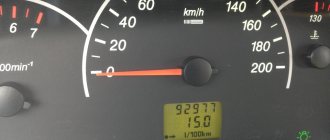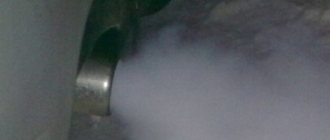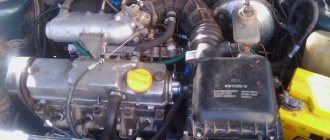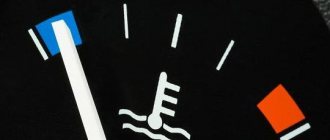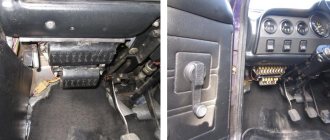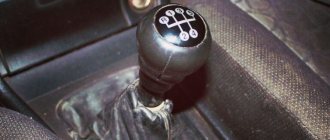Problem of supplying the engine with fuel and air mixture
A too lean air-fuel mixture is a fairly common problem that leads to serious engine malfunctions. Errors and disturbances in the mixture formation process can occur on carburetor or injection engines, as well as on power units with additionally installed gas equipment.
One of the main signs that shows deviations from the fuel assembly norm is unstable engine operation at low and idle speeds. As a result, the car begins to jerk and stall when starting to move.
For example, if a lean mixture is constantly supplied to the cylinders, the consequences can be quite serious. In a number of cases, the appearance of a white coating on the spark plugs and misfires have been noted; a lean mixture causes local overheating, burnout of valves and melting of the pistons.
General diagnostics of deviations from the fuel assembly norms begins with the ECM sensors. Typically, the P0171 code occurs due to a malfunction of the MAF sensor (mass air flow sensor). The fact is that the specified sensor ceases to respond in a timely manner to changes that relate to air flow. The cause is usually an accumulation of contaminants.
A poor fuel assembly of a car is the main reason why the car starts to twitch at low speeds
In this case, the control unit automatically reduces the fuel supply so that the amount of air increases. The result is a lean mixture at different operating modes of the power plant. After this, error P0171 occurs; in parallel, error P0100 or P0102 can be detected. Such codes usually indicate problems and malfunctions in the mass air flow sensor.
Reasons why a car may jerk while driving
This section lists all the most common reasons why a car shakes and jerks while driving. For convenience, potential malfunctions are divided depending on the fuel used and the mixture formation system. This will allow you to quickly determine why a car with a carburetor, injector, diesel engine, or equipped with gas equipment jerks while driving, or at least eliminate possible problems.
Why the car jerks while driving: reasons for different types of internal combustion engines
| Causes | Why does it twitch while walking? | |||
| Injector | Carburetor | On gas | Diesel | |
| Carburetor malfunction or blockage | ✘ | ✔ | ✘ | ✘ |
| Clogged air or fuel filter | ✔ | ✔ | ✔ | ✔ |
| Gas filter clogged | ✘ | ✘ | ✔ | ✘ |
| Clogged or worn injectors | ✔ | ✘ | ✔ | ✔ |
| Problems with spark plugs, coils or spark wires | ✔ | ✔ | ✔ | ✘ |
| Air leak into the intake manifold | ✔ | ✔ | ✔ | ✔ |
| Malfunction of TPS (throttle position sensor) or throttle actuator*** | ✔ | ✘ | ✔ | ✘ |
| Malfunction of sensors: accelerator, IAC (idle air control), MAF (mass air flow sensor), DTOZH (coolant temperature sensor), MAP (absolute pressure sensor) | ✔ | ✘ | ✔ | ✔* |
| Malfunction or poor contact of the crankshaft sensor (crankshaft sensor) | ✔ | ✘/✔**** | ✔ | ✔* |
| Fuel pump malfunction | ✔ | ✔ | ✘ | ✘ |
| Faulty injection pump (high pressure fuel pump) | ✘/✔** | ✘ | ✘/✔** | ✔ |
| Gas reducer is faulty | ✘ | ✘ | ✔/✘** | ✘ |
| Freezing of the gearbox or lines | ✘ | ✘ | ✔ | ✘ |
| Worn or incorrectly adjusted clutch | ✔ | ✔ | ✔ | ✔ |
| Incorrect operation of the gearbox | ✔ | ✔ | ✔ | ✔ |
| Wear of the CPG, malfunction of valves and hydraulic compensators | ✔ | ✔ | ✔ | ✔ |
| Low quality or unsuitable fuel | ✔ | ✔ | ✔ | ✔ |
* relevant only for diesel engines with a common rail injection system and similar ** relevant only for cars with direct injection and for 6th generation LPG systems for them, injecting liquid gas *** relevant for injection cars with an electronic pedal (e-gas) * *** relevant for carburetor cars with an electronic (contactless, microprocessor) ignition system
Diagnostics of modern cars is simplified by the presence of an ECU. If the car jerks while driving and the check engine light is on, basic computer diagnostics using OBD II will indicate the reason with a high degree of success. However, the indicator does not light up in case of any problems.
Finding out why a car with a carburetor jerks while driving can only be done by inspecting and checking potential locations of the problem.
The main reasons why a car jerks when driving: video
In cars running on gas or diesel fuel, much depends on the generation and features of the supply system.
In addition to the type of fuel and power system, the problem of the malfunction depends on the conditions under which the car begins to twitch:
- when moving forward at low speeds;
- when moving backwards;
- when picking up speed;
- when driving at a constant speed.
Why does the car jerk when driving in different modes?
Some malfunctions that lead to jerking appear only in certain driving modes, these include:
- Clogged or worn injectors . The injectors (on the injector, LPG 4+ generation and on the diesel engine) do not spray fuel correctly, which leads to worse ignition of the fuel assemblies, causing the engine to operate unstably and lose traction. To eliminate the problem, you need to wash the injectors or replace them.
- Carburetor clogged . Due to clogged jets, mixture formation is disrupted. To fix the problem, you need to flush the carburetor and flush the fuel line.
- Clogged fuel filters . Clogging of gasoline, diesel or gas filters leads to a decrease in the throughput of the fuel line. The solution to the problem is to replace the fuel filter.
New and broken crankshaft position sensor
The throttle position sensor fails when the contacts are worn out.
Checking the coolant sensor with a multimeter
- Fuel pump malfunction . A decrease in fuel pump performance leads to interruptions in fuel supply. The problem usually progresses with load: at idle it is weakly expressed, and when accelerating the engine openly jerks and stalls. To check the pump on an injection car, you need to measure the pressure in the fuel rail with a pressure gauge, on a carburetor - after the pump, on a diesel engine - at the outlet of the injection pump.
- DPKV malfunction . The crankshaft sensor determines the moment at which fuel must be supplied (and a spark - on gasoline / gas). It itself rarely fails, but if there are problems with the wiring, the signal is lost, the engine stalls, but starts up by inertia, which causes jerking and shaking.
- DTOZH malfunction . Modern internal combustion engines with an injection system (both gasoline/gas and Common Rail diesel) adjust the fuel supply and ignition based on the engine temperature. If the DTOZH is faulty, then the injection dose, ignition angles (gasoline, gas) or injection timing (diesel) will not correspond to real conditions, which is why the engine begins to operate unstably and loses power. The DTOZ is checked using computer diagnostics or a multimeter (you need to find a temperature resistance table).
Diagnostics of the TPS sensor: video
- Malfunction of the TPS or accelerator sensor . If the throttle position sensor or gas pedal is worn out (usually the potentiometer tracks are erased), the signal begins to “float”, which causes incorrect control of the remote control. To check the sensor, you need to measure the change in its voltage as you smoothly press the gas pedal (through diagnostics or with a multimeter). If sudden jumps or dips in voltage occur, you need to change the throttle or pedal sensor.
- Ignition problems . If the spark plugs, their coils or wires are worn out, misfires occur. In the early stages, the problem can only appear at idle, since at high speeds these gaps are partially compensated by inertial forces and are masked. To diagnose, you need to inspect the spark plugs, coils, and wires for breakdowns (sparks in the dark). You need to check the spark plugs, wires, coils, and after finding the culprit, replace the faulty elements.
- Air leak . If there is unwanted air leakage, the engine cannot properly dose fuel assemblies, the mixture becomes lean, traction is lost and jerking occurs. On carburetor engines with vacuum ignition control (and carburetor control, as, for example, on old Mercedes), the pumping ratio and gasoline supply are also disrupted. To find the location of the leak, you need to check the intake with a smoke generator. The main areas where air can leak are pipes and their clamps, carburetor flanges, throttle bodies, manifolds, receivers, and injector seals.
- Off-season fuel . The problem is typical for diesel engines and gas. Summer diesel fuel becomes waxy in winter and clogs the lines, so the engine either does not start at all, or starts with difficulty and runs poorly. The summer propane-butane mixture (with a predominance of butanes) behaves similarly in winter, which evaporates poorly in cold weather. To fix the problem, you need to defrost the diesel fuel and refuel according to the season. It’s more difficult with gas, since to refill you need to first drain some of the gas, taking precautions (it’s better to visit a gas service station).
- Bad fuel . If gasoline, gas or diesel is counterfeit, of low quality, or the octane/cetane number does not match the required one, the fuel will ignite and burn worse. Driving on such fuel is fraught with problems in the internal combustion engine and exhaust system, so you need to drain it, flush the fuel system and refuel with high-quality fuel.
Checking the mass air flow sensor using a multimeter
The absolute pressure sensor requires periodic cleaning
- DBP malfunction . If the absolute pressure sensor used in gasoline engines without a mass air flow sensor and on the 4th generation LPG does not operate correctly, the composition of the air-fuel mixture is disrupted. You need to check the DBP, and if it is faulty, replace it.
- DMRV malfunction . A faulty mass air flow sensor provides incorrect data on the amount of air entering the intake manifold, causing the ECU to dose fuel incorrectly. You can check the mass air flow sensor by measuring its voltage (with a multimeter or through diagnostics) when idle. For example, for injection VAZs, a voltage of less than 1 V indicates the ideal condition of the flow meter, from 1 to 1.02 - normal, from 1.03 to 1.05 - signs of wear, and more than 1.05 V - critical wear.
- Wear of the CPG, malfunction of valves and hydraulic compensators . If the engine is badly worn, the valves are burnt out or the valves are set unevenly, compression drops. As a result, the reason why the car jerks at idle is weak and uneven pressure in different cylinders. The moments of force created by the pistons differ from each other, and this causes shaking. To check, you need to measure the pressure in the cylinders; it should differ between “boilers” by no more than 1 atm. Incorrectly set gaps must be adjusted, faulty hydraulic compensators must be replaced. Burnt-out valves and pistons will have to be replaced by removing the head, and if the cylinders are worn out, the entire internal combustion engine will have to be overhauled.
Below we will look in detail at the reasons why a car jerks while driving, what causes shaking at idle, and what can cause jerking when moving slowly.
All problems with sensors described here and below require checking both the sensors themselves and their wiring. Sometimes a working part does not work correctly due to poor contact, oxidation of terminals, rubbing of insulation, broken wires and other similar problems. Therefore, before buying a new sensor, inspect the connectors and check the wires with a multimeter!
Why does the car jerk when idling?
If the car jerks when idling, but behaves normally when the pedal is pressed, problems with the fuel supply system can be ruled out. They usually appear just when more fuel is needed. The most common malfunctions that cause jerking on idle are:
The car jerks at idle, finding and solving the problem: video
- IAC malfunction . On injection cars, air is admitted when the throttle is closed through a bypass channel (bypass), the throughput of which is regulated by the idle air regulator. If it is faulty or the channel is clogged, air will not be supplied correctly, the motor will begin to twitch and trip. If the car jerks at idle due to IAC, you need to replace it to fix the problem.
- Incorrect XX setting on the carburetor . On the carburetor, the idle speed is controlled by screws for the quantity and quality of the mixture, if the position is incorrect, the engine may adjust. The problem can be resolved by adjusting the position of the screws.
- Clogged jet XX . In addition to the screw adjustment, the supply of fuel assemblies at idle speed is regulated by a separate jet, which, when clogged, supplies insufficient fuel. To fix the problem, you need to clean the jet, and preferably the entire carburetor.
- Incorrect gearbox setting . In HBO systems up to the 3rd generation, the idle speed is adjusted with a separate screw that regulates the gas supply bypassing the membrane. If it is positioned incorrectly, the gas dosage will be disrupted. To eliminate the problem, you need to adjust the fuel until engine operation stabilizes.
- Early inclusion of gas . On engines with gas equipment that have automatic fuel switching (based on engine speed or temperature sensor), shaking and tripping at idle may be a consequence of switching to gas before the gearbox warms up. In such cases, the lines or the gearbox itself freeze up, the gas supply slows down, and the engine “starves”. To avoid tripping, you need to switch to HBO when the engine temperature reaches +40-50 degrees or more. On GBOs of the 2nd and 3rd generations, in order to avoid early transition and freezing, you should not use too much gas until the internal combustion engine warms up, and on GBOs of the 4th and 5th generations, you need to check and, if necessary, adjust the temperature in the GBO controller.
If there are no problems at idle, but the car jerks while driving, the following sections will help you understand the reason.
The car jerks when driving at low speeds
If the car moves jerkily or the car starts to twitch at low speeds while driving, the reasons may be the following:
What is the reason when a car jerks while moving at low speeds: video
- Wear of drive joints . If the car jerks when starting to move, the cause may be wear on the CV joints, if accompanied by a characteristic crunch, or a malfunction of the cardan crosspieces. Excessive play in the hinges generates shock loads in the transmission, which is why the jerk occurs. You can check the parts for play by driving the car onto a pit or a lift and turning the drive shafts or cardan by hand.
- Throttle clogged . A dirty throttle does not allow enough air to pass through at a small opening, which is why the mixture is dosed incorrectly, the engine runs worse and the car jerks when driving at low speeds. The valve is checked visually, and if there are deposits, it must be washed with carburetor and throttle valve cleaner.
- Incorrect setting of HBO . Incorrectly adjusted gas equipment (for example, an overtightened membrane on the HBO-2) may not add fuel or overfill fuel at low speed. Correct diagnostics of gas equipment of the 4th generation and newer is computer-based; for older systems, gas analysis using ShDK.
- Problems with automatic transmission . If the torque converter box kicks and the car jerks at low speed, you need to diagnose the gearbox and its torque converter (“donut”). Most often, the cause lies in a lack of oil pressure caused by low lubrication levels or pump wear. First you need to measure the oil level and assess its condition. If the lubricant is in order, disassembly and troubleshooting of the box will be required.
- Clutch slipping . When driving under tension in a car with a manual or manual transmission, a worn or overtightened clutch is overloaded. If at some point it becomes easier for the motor to turn the disk than the wheels, a jerk occurs. You can check the clutch by sharp acceleration. In addition, its slipping is usually accompanied by the characteristic smell of a burnt clutch.
- The throttle actuator is faulty . On a car with an E-gas system, the throttle valve is controlled by the ECU using an electric drive, the malfunction of which leads to its insufficient opening. You can check the throttle assembly visually by assessing its opening depending on the position of the gas pedal.
- Brakes jamming . If the brake pads grab the discs (this happens due to clogged circuits, pinched tubes, skewed caliper guides and other problems), the motor has to overcome additional resistance. This is what causes the jerking. Usually the problem is accompanied by a deterioration in the braking properties of the car (increased braking distance) and overheating of the discs/drums with pads. Since the discs and pads warm up at speed, inertia builds up - the jerking goes away, but the car slows down worse.
Car jerks when reversing
If the car jerks when you engage reverse gear, this is mainly due to problems with the gearbox, and four main reasons can be identified:
Typical wear of the reverse gear in a manual transmission
- Automatic transmission overheating . In an overheated gearbox, the oil loses its viscosity and becomes thinner, which disrupts the operation of the gearbox. Reverse speed is one of the first to suffer from this.
- Lack of automatic transmission oil . If the oil level in the gearbox is insufficient, jerking is also possible when the rear gearbox is engaged.
- Automatic transmission malfunction . Malfunctions and blockages of the valve body, solenoids, oil pump or clutches cause jerking when reversing. Breakdowns can be identified during troubleshooting, since without disassembling “by eye” it is almost impossible to find the cause.
- Wear of the manual transmission reverse gear . The rear gear of most manual transmissions is unsynchronized, so when used frequently, it wears out much faster than the front ones. In straight-toothed pairs, the teeth wear down (just like on the starter ring), which is why the gears can slip and the car jerks when reversing.
The car jerks when driving when accelerating
When accelerating, the car jerks mainly for the following reasons:
- Wiring problems . When accelerating hard, the motor deflects (especially if the mounts are worn), which can cause contacts to come loose from sensors and other electrical components. On the injector it is necessary to carry out diagnostics and clean the contacts, eliminate breaks or short circuits, and replace damaged connectors.
- Clogged air or fuel filter . If the filters are slightly clogged, the lack of air or fuel only manifests itself under load and at high speeds.
Connecting a pressure gauge to the fuel rail to measure pressure in the fuel system
- Problems with the fuel pump . Lack of fuel pressure is a common reason why a car jerks when you press the gas. If the fuel pump or fuel injection pump is slightly worn, it is still capable of developing the required fuel supply pressure at idle, but cannot cope under load, the engine is “starving” and cannot develop its designed power. Pumps are checked by measuring pressure.
- Blockage or malfunction of the second chamber of the carburetor . The second chamber of the carburetor is usually responsible for powering the engine under load. If it is clogged, incorrectly adjusted or faulty (for example, a wedge or a broken damper rod), it cannot supply gasoline vapor in the required quantity.
- “Strangled” or incorrectly selected HBO . An incorrectly configured gas system (often inexperienced drivers and tuners do this to save gas) or an insufficiently efficient gearbox (for example, a 140 hp gearbox on a 120–130 hp engine) behaves in the same way as an incorrectly functioning carburetor or injector. At peak loads there is not enough gas, which is why the car jerks when driving when accelerating. Systems of the 4th generation and newer are diagnosed using a computer method, older ones - by adjustment by ear or (which is better) gas analysis with ShDK.
Sometimes the car jerks at high speeds when starting or accelerating due to low fuel levels. Since the fuel in the tank or cylinder flows back by inertia, the fuel intake can become exposed and capture vapor instead of liquid, causing a drop in pressure!
Incorrectly set car ignition
Incorrectly set ignition is another common reason why a car starts to jerk at low engine speeds.
Signs of early ignition, as well as late, imply an advance or delay in the operation of the “ignition” system in relation to the position in which the piston is located in the cylinder. In other words, the spark plug ignites the fuel-air mixture not at the most optimal moment for this, but earlier or later.
This became the reason for the fact that in cars in which it is possible to adjust the ignition timing independently, car enthusiasts are often faced with the need for correct settings. How to determine whether ignition is late or early? The following is a list of signs by which an incorrectly set ignition is determined:
- Difficulty starting the power unit.
- The engine overheats and detonates.
- The accelerator pedal becomes less responsive.
- Unstable idle.
- The power potential of the engine is reduced, and throttle response is also lost.
Fuel consumption increases significantly. An incorrect OZ can also show itself in the form of specific pops that are heard in the carburetor, in the exhaust system, etc.
This leads to a very obvious conclusion: further operation of a power unit with incorrect safety regulation can lead to more serious consequences. The consequences will be especially negative if detonation occurs regularly.
A little about the correct ignition setting on the VAZ Classic
How to find the reason and what to do
On a car with an injector, you need to find out why the car starts to twitch while driving, by diagnosing and reading errors. If there is a BC that displays their codes, no additional equipment is needed, otherwise an OBD II scanner and software for it are required. Common error codes indicate problems with such nodes:
Diagnosis of why the car jerks: video
- P0100-0104 – Mass air flow sensor;
- P0105-0109 –DBP;
- P0110-0114 – intake air temperature sensor;
- P0115-0119, P0125-0126 – coolant temperature sensor;
- P0120-0126, P0220-0229 – TPS;
- P0200-0215, P0251-0296 – injectors;
- P0218 – gearbox overheating;
- P0230-0233 – fuel pump;
- P0335-0339 – DPKV;
- P0350-0362 – ignition coils, wiring, or control unit.
Without computer diagnostics, you will have to check why the car started to twitch while driving, by inspecting the components one by one. The general sequence of actions is shown below.
Damage to the accelerator (gas pedal)
Mostly, problems with car jerking at low speeds are associated with electrical circuits. The pedal support is equipped with a pair of sensors. Their task is to transmit signals for changing the accelerator position.
There is an indicator on the panel that will indicate a system malfunction. If one sensor is damaged, the engine speed increases at a low speed. If both devices break down, the emergency mode is activated and the engine runs at idle.
As a result of a breakdown, the pedal must be replaced, since the sensors cannot be restored. Loss of wiring integrity leads to a malfunction of the throttle. If the electric motor becomes unusable, the information on the monitor will display an error indicating an accident. These problems can be easily solved. If the accelerator of the electronic gas pedal breaks down, it is replaced with a new one.

